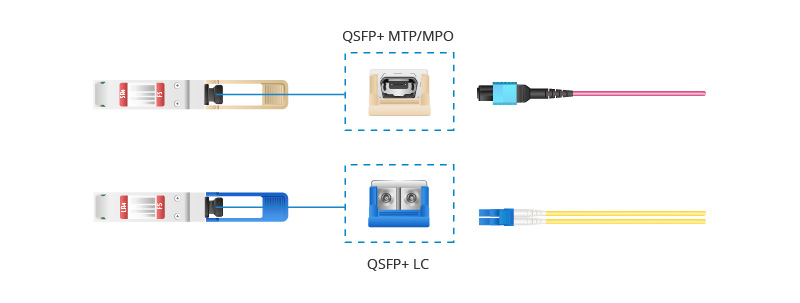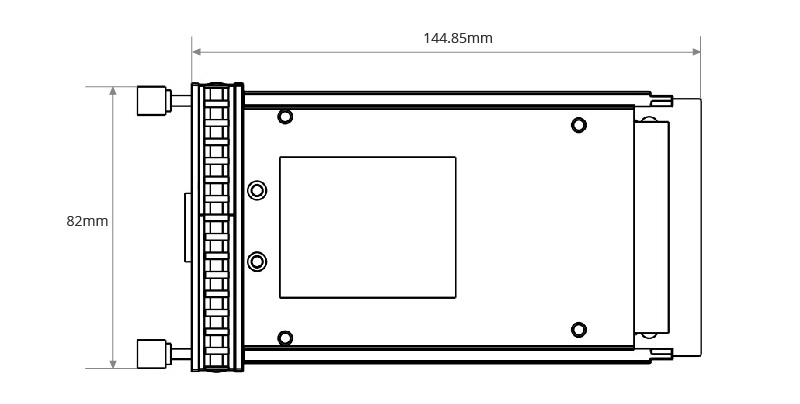What Is QSFP+ Module: QSFP+ Transceiver Wiki and Types
There is no denying that 40G Ethernet technology is more mature compared with the newly emerged 25G Ethernet, and there are various types of relevant products for 40G applications in the market. Therefore, some network managers still tend to adopt 40G Ethernet networking as a safe and reliable choice in data centers. As one of the key components of 40G Ethernet, 40G QSFP+ optical transceiver is inescapably compelling. Then what is the QSFP+ module and how many types of it? And what're the differences between 40G QSFP+ and 40G CFP modules?
40G QSFP+ Transceiver Wiki
What Is QSFP+ Module?
As the evolution of QSFP (quad small form-factor pluggable), the QSFP+ module is a compact, hot-pluggable transceiver used for 40Gbps speed. It is compliant with SFF-8436 and QSFP Multi-source Agreement (MSA). There are 4 independent 10Gbps data lanes in each direction to support 40Gbps aggregate bandwidth. QSFP+ has been widely used in 40GBASE-X Ethernet, breakout to 10GBASE-X Ethernet, data center aggregation and backplane applications, and datacom switch and router connections. The following figure illustrates the QSFP+ dimensions.

Figure 1: QSFP+ mechanical dimensions
What Are the Interfaces of QSFP+ Module?
QSFP+ transceivers are designed to install into any QSFP+ port (and part of QSFP28 port), allowing for 40GBASE-X interfaces to the network through the QSFP+ connector. Generally, the interfaces of 40G QSFP+ modules can be either duplex LC or MTP/MPO (short as "MTP" in the following introduction). There are some distinct differences between the two interfaces: transmission distance, cable type, and availability of 4x10G connectivity, etc. If you want to get more information about the analysis and comparison of the two interfaces, please visit: 40G QSFP+ MTP vs 40G QSFP+ LC Transceivers.

Figure 2: QSFP+ interfaces: MTP vs LC
How Many Types of QSFP+ Transceivers?
There is a variety of 40G transceivers currently available on the market. It is of great significance to distinguish these different types and select the right one that suits your needs. Nine common types of QSFP+ transceivers will be introduced respectively in the follow-up paragraphs.
QSFP+ Transceivers With Parallel MTP Interface
Four modules—40GBASE-SR4, 40GBASE-CSR4, 40GBASE-PLRL4, and 40GBASE-PLR4 will be introduced one by one. All of the transceivers are MTP interfaced and available for scenarios requiring four 10GbE ports from a single QSFP+ interface.
40GBASE-SR4
40GBASE-SR4 is probably the most popular 40G transceiver for short-distance transmission. It works through multimode fibers, and its link length can reach 100 m over OM3 and 150 m over OM4. The 40GBASE-SR4 module has four transmit and four receive lanes of 10G, which can achieve combined 40G signal sending and receiving.
40GBASE-CSR4
As an upgrade version of SR4, the 40GBASE-CSR4 module shares the same principle with 40GBASE-SR4 in which they both have an MTP interface. In addition, 40GBASE-CSR4 can also be used for 40G optical links over 12-fiber parallel cables with MTP female connectors or in a 4x10G breakout mode with parallel to duplex fiber breakout cables for connectivity to four 10GBASE-SR interfaces. The difference is that the CSR4 can support longer transmission of data—up to 300m over OM3 and 400m on OM4.
40GBASE-PLRL4
QSFP+ PLRL4 refers to "QSFP+ parallel LRL4." In general, digital data transmission can occur in two basic modes: serial or parallel. To put it simply, multiple bits are sent simultaneously on different channels within the same cable in parallel transmission. Like SR4 and CSR4 modules, the 40GBASE-PLRL4 module also uses parallel transmission which is combined with MTP connectors. Unlike the previous two modules, 40GBASE-PLRL4 can support long-haul transmission up to 1 km or 1.4 km over SMF.
40GBASE-PLR4
40GBASE-PLR4 transceiver terminates with MTP connectors to achieve parallel transmission. What's more, like 40GBASE-PLRL4, 40GBASE-PLR4 can support 4 individual 10G-LR connections using a 4×10G mode and fiber breakout cables for single mode fiber. Designed for long data transmission like 40GBASE-PLRL4, the link lengths of 40GBASE-PLR4 can reach up to 10 km.
QSFP+ Transceivers With Duplex LC Interface
40GBASE-BiDi, 40GBASE-UNIV, 40GBASE-LR4, 40GBASE-LR4L, and 40GBASE-ER4 will be illustrated in sequence next. All of them operate with LC connectors. However, 40GBASE-BiDi is the only one that transmits data just over MMF for short distances.
40GBASE-BiDi
40GBASE-BiDi has the unique capability to transmit full-duplex 40G traffic over one duplex MMF cable with LC connectors. In other words, the QSFP+ BiDi transceiver supports 40G connection over one pair of MMF cables while allowing 40G to be deployed using the same infrastructure as 10G (10GBASE-SR) without adding any fibers. The 40GBASE-BiDi module is a short-reach optical transceiver that can reach 100 meters on OM3 or up to 150 meters over OM4.
40GBASE-UNIV
This module is called "universal" because of its ability to operate with both MMF and SMF without the need for any software/hardware changes to the module or any additional hardware in the network. Therefore, the extra cost and deployment time will be saved. 40GBASE-UNIV module has 4 channels of 10G multiplexed inside the module to transmit and receive an aggregate 40G signal over 2 strands of fiber. It can support the same transmission distance over OM3 and OM4 fibers (i.e., 150 m), and also achieve link lengths of up to 500 m to 2 km (vary from different vendors) over a single mode fiber cable. Click here to get further introduction of 40GBASE-UNIV.
40GBASE-LR4
While the widely-used module 40GBASE-SR4 is used for short-distance transmission, the 40GBASE-LR4 module, on the contrary, is for long-range data transmission. This QSFP+ type's link length is up to 10 km via a single mode fiber cable accompanied with duplex LC connectors. 40GBASE-LR4 multiplexes the four sending lanes onto one fiber strand and the four receiving lanes onto another single fiber strand instead of using one single fiber strand for each lane.

Figure 3: The working principle of 40GBASE-LR4 transceivers
40GBASE-LR4L
40GBase-LR4L, namely 40GBase-LR4 Lite, has the same fundamentals as the 40GBase-LR4. Both of them are used for long-range 40G data transmission over single mode fiber cable. The major distinction is that the LR4L module can only reach up to 2 km in transmission distance.
40GBASE-ER4
The last QSFP+ module that will be introduced can handle the longest transmission distance of data up to 40 km over SMF with duplex LC connectors. It has the same working principle as 40GBASE-LR4 mentioned before.
See the table below for unambiguous illustration and comparison:
| Type | Connector Interface | Cable Type | Wavelength | Max. Distance | Also Called |
|---|---|---|---|---|---|
| SR4 | Parellel MTP | MMF | 850nm | 100m@OM3; 150m@OM4 | iSR4 |
| CSR4 | MMF | 850nm | 300m@OM3; 400m@OM4 | XSR4/ESR4/SR4E/eiSR4 | |
| PLRL4 | SMF | 1310nm | 1km or 1.4km | PIR4/LRL4 | |
| PLR4 | SMF | 1310nm | 10km | N/A | |
| BiDi | Duplex LC | MMF | 832nm-918nm | 100m@OM3; 150m@OM4 | SR-BD/SR-BiDi |
| UNIV | MMF/SMF | 1310nm | 150m@OM3/OM4 MMF; 500m to 2km SMF | LX4/LM4 | |
| LR4L | SMF | 1310nm | 2km | IR4 | |
| LR4 | SMF | 1310nm | 10km | N/A | |
| ER4 | SMF | 1310nm | 40km | N/A |
40G QSFP+ vs 40G CFP: What's the Difference?
What Is 40G CFP?
CFP, short for C form-factor pluggable, is compliant with MSA to produce a common form-factor for the transmission of high-speed digital signals. This standard was primarily designed for 100 Gigabit Ethernet systems, but it can also support 40GbE. There are three main types of 40G CFP modules, 40GBASE-SR4 CFP is applied for 150m transmission on OM4 MMF with MTP connectors; 40GBASE-LR4 CFP is designed for 10km transmission on SMF with SC duplex connectors and 40GBASE-FR CFP is used for 2 km transmission on SMF with SC duplex connectors. The following figure illustrates the CFP dimensions.

Figure 4: CFP mechanical dimensions
What Is the Difference Between QSFP+ and CFP?
First, a CFP module is quite large in size visually, which would not support stacking or ganging but with a higher pricing. The interface of a CFP module is MTP or SC duplex, which is different from the MTP or LC interface of the QSFP+ module as well. Besides, 40G CFP modules have relatively limited types, so they can't satisfy users' diversified demands for different distances. In a word, QSFP+ is smaller in size and relatively inexpensive with higher flexibility and wider application compared with 40G CFP.
Summary
As the researches show, the communication network is in urgent need of the optical transmission bandwidth upgrade from the original 10G to 40G and even 100G. 40G QSFP+ modules guarantee high-density, cost-effective and low-power 40G data transmission, leading a bright future. Understanding what QSFP+ is, 40G QSFP+ module interfaces, types, and applications is the prime task before selecting the optimized transceivers for your data facility. Hopefully, this paper will give you some inspiration about 40G QSFP+ and 40G CFP transceiver modules.
You might be interested in
Email Address

-
PoE vs PoE+ vs PoE++ Switch: How to Choose?
Mar 16, 2023














